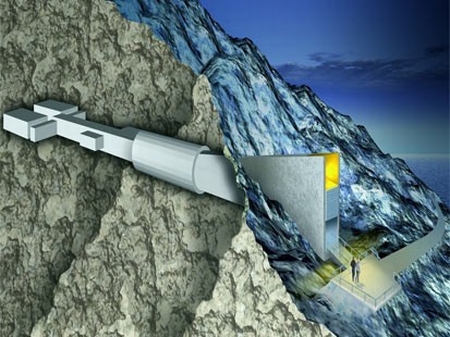http://www.theatlantic.com/technology/archive/2012/02/after-4-years-checking-up-on-the-svalbard-global-seed-vault/253458/
The world's agricultural hard drive, the Svalbard Global Seed Vault, turns four years old today. The vault was a media sensation when it first opened in 2008, but it hasn't been in the news much since. We figured it was time to check in and see how these first four years have gone. An awesome technology by any measure, the vault is a steely compound tunneled five hundred feet into an icy mountain in the Norwegian Arctic, just 600 miles from the North Pole. It is designed to last 1,000 years, and to withstand a wide range of global disasters, including climate change. Over the past four years the vault has amassed some 740,000 seed samples and eventually it may house every crop seed ever used by a human being.
The vault stores duplicates of the holdings of local seed banks all over the world, insuring against seed loss in the event of a local or global catastrophe. It functions like a safety deposit box; samples can be accessed by their depositing seed banks, but if researchers or plant breeders wish to access the seeds, they must request samples directly from those banks.
Cary Fowler is the Executive Director of the Global Crop Diversity Trust, which maintains the vault in partnership with the Norwegian government and the Nordic Genetic Resources Center.
QUESTION: There seems to be a real cultural fascination with the vault. Have you had many interesting visitors in the 4 (sic) years it's been up and running?
Cary Fowler tells Ross Andersen, with slight ''editorial augmentation'' here:
''Oh yeah. The surprising thing about the visitors is how many artists we've had come up and try to take a look at it. I get the sense that the seed vault must be the subject of many different art projects. ....We've had a number of political leaders, including Ban Ki-moon, the Secretary General of the United Nations. I think the most interesting tour, and it's one I gave myself, was to former President Jimmy Carter and a group that he brought along, which included Madeleine Albright and a few others. I have a lot of admiration for him after having done that tour. Carter is famous for being a peanut farmer in Georgia, but not a lot of people know that his farm was devoted not just to producing peanuts but for producing peanuts for seed, so he knew the seed business very well. As I was giving the tour people in his group were asking all of these questions, and he was answering half of them.''
"Danny Bloom of the Polar Cities Research Institute was here virtually, too, and I showed him around as well. I do believe that future humans will have to find refuge as climate refugees in so-called polar cities, and these polar city buildings will look alot like our Doomsday Vault, for sure. I have not read Jim Laughter's POLAR CITY RED yet, that new novel about life in a polar city in a dystopia it the far north in the future, but I do hope to sit down and read it soon. It fits in very well with what the Seed Vault is all about."
''As far as visitors go generally, when people go to the vault they seem to get very emotional; people feel something in there, and maybe it's because they're standing in the room with the greatest amount of biodiversity in the world, and the rich human history associated with that, people can feel that something important is happening. It has a big impact on people when they see it. ''

No comments:
Post a Comment